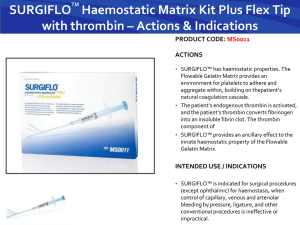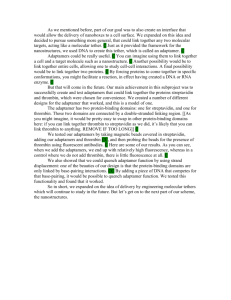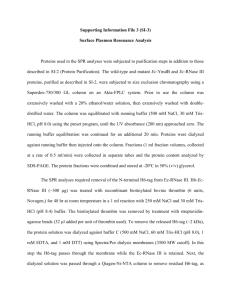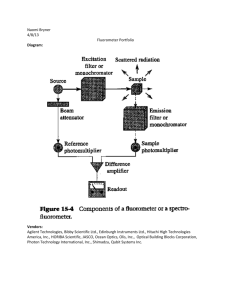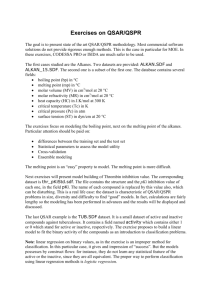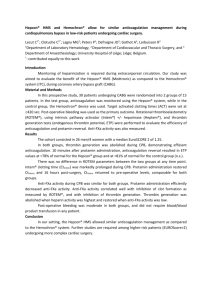Mechanistic Studies of the Inhibition of Human α
advertisement
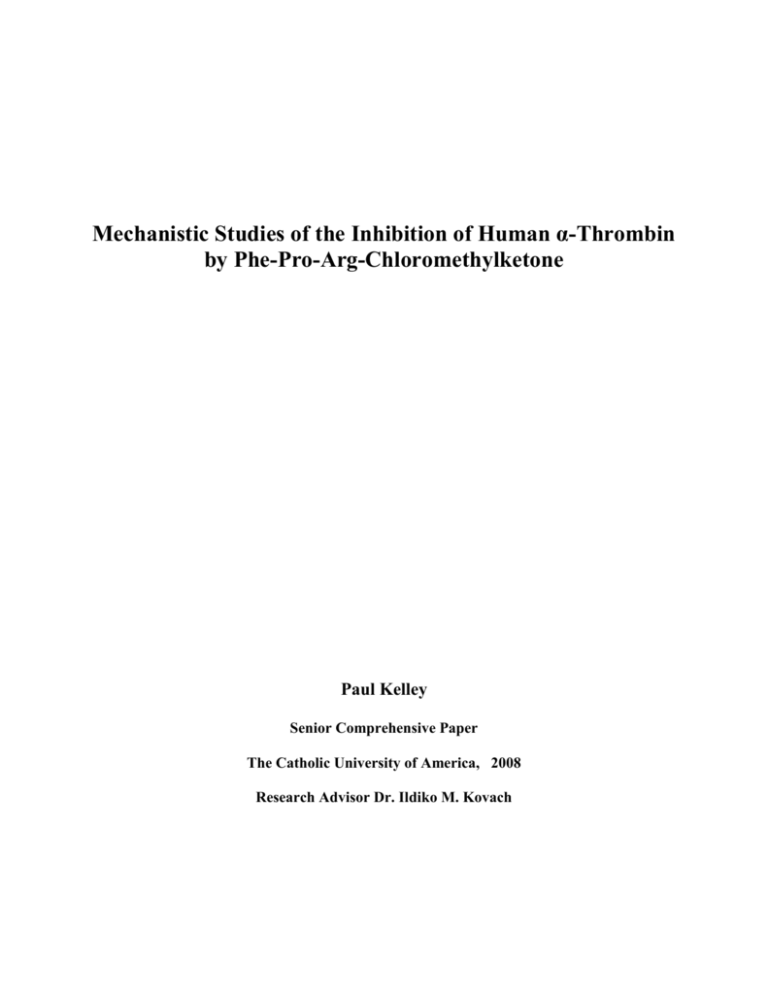
Mechanistic Studies of the Inhibition of Human α-Thrombin by Phe-Pro-Arg-Chloromethylketone Paul Kelley Senior Comprehensive Paper The Catholic University of America, 2008 Research Advisor Dr. Ildiko M. Kovach Abstract: Thrombin is a pivotal serine protease enzyme in the blood cascade system. Phe-Pro-ArgChloromethylketone (PPACK) forms a covalent bond with the active-site Ser of thrombin and cross links with His57 at the active site. As PPACK is a mechanism-based inhibitor, it may be a good mimic of intermediates formed in reactions catalyzed by thrombin. Therefore, the dependence of the inhibition of human α-thrombin by PPACK on inhibitor concentration, pH, and temperature was investigated and pKa1, pKa2, k2, Ki, ΔS‡, and ΔH‡ were calculated. The values of pKa1 and pKa2 are 7.3 ± 0.2 and 8.8 ± 0.3, respectively, at 25.0 ± 0.1 °C. The firstorder rate constant, k2, and the second-order rate constant, k2/Ki, for inhibition of human αthrombin by PPACK are 0.23 ± 0.02 s-1 and (5.29 ± 0.3) x106 M-1 s-1 at pH 7.47 in 0.05 M phosphate buffer, 0.18 M NaCl, and 25.0 ± 0.1˚C. The inhibition constant, Ki, was calculated to be (4.4 ± 0.4) x10-8 M at the same pH buffer and temperature. The activation parameters at pH 7.47, 0.05M phosphate buffer 0.18 M NaCl, are ΔS‡ -34 ± 3 cal/mol deg and ΔH‡ 10.0 ± 0.8 kcal/mol, characteristic of enzyme-catalyzed reactions. The deuterium solvent isotope effect for the second-order rate constant at pH 7.0 and 8.3 at 25.0 ± 0.1˚C is unity, indicating the absence of a proton transfer in the rate-determining step for the association of thrombin with PPACK. But in a 600 MHz H NMR spectrum of the inhibition adduct at pH 6.7 and 30 °C, a peak at 18 ppm appears, which is absent in the H NMR spectrum of a solution of the enzyme. The peak at low field is typical of a short strong hydrogen bond forming at the active site in the adduct. The deuterium isotope effect on this hydrogen bridge is 2.1 ± 0.2. 2 Introduction Physiological Role of Thrombin. Probably one of the most important of all physiological functions in human and mammalian species is the process of forming and breaking down blood clots. Blood clots must be formed quickly after injury to prevent hemorrhage, but also the clotting must be stopped in order to prevent thrombosis.1,2 A large variety of different enzymes are used to regulate this fine balance between these two drastic sides of clotting to prevent serious injury. Thirteen of these enzymes are involved in the biochemical cascade to activate the ultimate enzyme of the cascade, αthrombin. Thrombin is by far the most important enzyme in the cascade. Thrombin is responsible for the cleavage of fibrinogen to fibrin to form blood clots to prevent hemorrhage and is also responsible for the degradation of the blood clots to prevent thrombosis. Also, thrombin serves to activate other blood coagulation factors, which activates more thrombin molecules through positive feed back.2 Because of its physiological importance in being the penultimate product in the blood coagulation cascade, thrombin is a subject of this study. Structure of Thrombin. Thrombin is a serine protease in the trypsin family. In character thrombin is trypsin like. This means that thrombin has a similar structure to and a catalytic mechanism like trypsin and its preference in substrates is like that of trypsin. Thrombin cleaves scissile peptide bonds adjacent to positively charged residues, such as arginine and lysine, similar to trypsin.3 Thrombin is composed of two domains the A domain and the B domain. The B domain contains the catalytic activity and is homologous to the reactive domains of other trypsin like serine proteases.4 As shown in Figure 1, the whole enzyme is almost spherical, it has the dimensions 45 x 45 x 50Å3. Although thrombin has two separate domains, the domains are connected by disulfide bonds and 3 so it forms a single continuous body.4,5 The active site of thrombin is buried in a deep narrow canyon. The canyon is created from two insertion loops, the 60 and γ-insertion loops, which are positioned over the active site. The 60 loop is hydrophobic in nature and rigid due to two consecutive prolines. The γ-insertion loop is adjacent to the active site and is more hydrophilic in nature. These loops help contribute to thrombin’s amazing specificity by restricting access to the active site.6 Thrombin has a preference for arginine in the S1 subsite, proline in the S2 subsite, and a hydrophobic residue, preferably aromatic, in the S3 subsite. Figure 1. The X-ray structure of human α-thrombin7 Active Site of Thrombin. In the catalytic site thrombin like most chymotrypsin like enzymes contains a catalytic-triad consisting of His57, Asp102, and Ser195. The mechanism of protein-peptide hydrolysis 4 catalyzed by thrombin is shown in Figure 2. In the first step, the Ser195 is activated by the His57 which acts as a base to remove the proton from the Ser195 and thus activates it. The His57 is supported in this action by the Asp102 which holds the His57 in place via a hydrogen bond. The now γ-O- of the activated Ser attacks the carboxyl group of the substrate and forms a tetrahedral intermediate which is stabilized by mainchain amides which form the “oxyanion hole” for the oxyanion. A proton from His57 is then donated to the N of the leaving group in the tetrahedral intermediate which causes the collapse and release of the product amine and the formation the acylenzyme intermediate. The acylenzyme intermediate is attacked by water with help once again from His57 to form another tetrahedral intermediate. The collapse of this tetrahedral intermediate releases the product acid and returns the starting enzyme.8, 9 In laboratory experiments, especially enzyme activity assays, chromogenic or fluorogenic small peptide substrates are used. Upon thrombin-catalyzed hydrolysis, these peptide anilides release the leaving group in stoichiometric amount to substrate loss. It has been speculated that the hydrogen bonds across the catalytic triad contract during catalysis, which brings down the activation barrier for the reaction in serine protease catalysis. As thrombin is a very efficient catalyst that catalyzes the breakdown of its natural and analytical substrates, it is a likely candidate for performing such structural change to stabilize the transition states for hydrolysis of its substrates. This idea is supported by the observed large solvent deuterium isotope effects in the hydrolysis of many thrombin substrates.8 As these isotope effects are between 2.5 and 3.5, they are most likely primary effects. This means that protons are transferred in the rate-determining step of the hydrolysis reaction. 5 Figure 2: Catalytic mechanism of thrombin 8 6 The origin of this difference between proton and deuteron transfer at the transition state lies in the loss of the difference in zero point energies existing in the ground state vibration of H/D in bonds to other atoms. 10 In the last decade, another probe of hydrogen bonds has been advocated. It has been observed in transition state analog adducts of enzymes with transition state analog inhibitors that a unique signal appears in high resolution H NMR spectra at low field between 14 and 21 ppm, in some cases. This phenomenon has been interpreted as the presence of a strong short hydrogen bond (SSHB) at the active site of the enzyme when interacting with the adduct. It has since been shown that the hydrogen bond is most likely the one formed between His57δNH and Asp102γO in serine proteases.11 One of the best transition state analog inhibitors of thrombin is D-Phe-Pro-Arg-chloromethylketone (PPACK).6,11,12 Structure of PPACK PPACK is a potent inhibitor of thrombin.12, 13 The potency of PPACK as an inhibitor lies in the composition of the peptide portion of the inhibitor. As shown in Figure 3, PPACK contains the critical arginine in the P1 position, a proline in the P2 position, and it contains a hydrophobic aromatic phenyl group in the P3 position. Because the structure of PPACK complements the subsites around the thrombin active site it is a potent inhibitor.6,12 PPACK is an inhibitor because it cannot undergo normal hydrolysis catalyzed by thrombin. 7 Figure 3. PPACK structure 14 The Mechanism of Inhibition of Thrombin by PPACK. The mechanism of inhibition starts similar to the cleavage of the normal substrate. However, when the Ser195 adds to the carboxyl group there is no bond to be cleaved. Because of this the inhibitor forms a covalent bond to Ser195 and subsequently cross links by alkylating His57, as shown on Figure 4. Figure 4. Structure of PPACK inhibiting the catalytic triad of thrombin 8 This results in an irreversible inhibition of the enzyme by the inhibitor. The correspondence between the subsites of the enzyme and the positions of the amino acid residues on the inhibitor help to guide the inhibitor to the active site. As the covalent adduct forms, the H-bonds in the catalytic triad may become compressed. As pointed out previously, the best probe of the formation of a SSHB in the inhibited thrombin is a high resolution H NMR measurement. An SSHB is expected to have a weak signal below 14 ppm. This conjecture can be further investigated by the pH dependence of the reaction, the sensitivity of the reaction to D-substitution for H at exchangeable sites on the protein by running experiments in D2O buffer. Temperature dependence studies of the inhibition reaction also give useful information about the transition state structure of the rate determining step. Goal: The goal of this research was to fully characterize the kinetics of inhibition of α-human thrombin by the inhibitor PPACK. The interest of our group was in the SSHBs that α-human thrombin forms for stabilization of intermediates during its catalytic mechanism with its natural substrate. The SSHBs could be detected by high resolution low field H NMR techniques. To perform these studies we thought it was critical to first fully characterize the nature of the inhibition that we chose to mimic the transient state of the natural reaction that forms the SSHB. Methods and Experimental Design Materials All inorganic salts and buffer components used were analytic grade chemicals and were purchased from Sigma-Aldrich. All water was double distilled from a copper-bottom still, passed through a Barnstead mixed bed ion exchange column and further distilled after collection. The 9 human α-thrombin was obtained from Enzyme Research Laboratories, Inc. and was at 3000 NIH units/mL which corresponds to ~1.6x10-5 M. The thrombin substrate used, H-D-Phe-Pip-Arg-pnitroanaline (S-2238), was purchased from DiaPharma. The inhibitor PPACK was purchased from BioMol. Buffers Buffer solutions were prepared from the appropriate analytical grade salts using double distilled de-ionized water. All buffers were 0.05 M of the respective buffer salt and 0.17-0.19 M of NaCl with 0.1% PEG-4000 added. Calculated amounts of HCl or NaOH were used to adjust the buffer pH when needed. All buffers were further filtered using a 0.2 μm Nylon Membrane Filter. For the pH dependence study buffers were made to cover a pH range from pH 6.0 to pH 8.5. Phosphate buffer was used for pH 6.03, 6.99, and 7.47. Citrate buffer was used for pH 6.52 and HEPES buffer was used for pH 7.49 and 7.79. Barbital buffer was used for pH 8.07 and 8.54, while Tris was used for pH 8.28. For the isotope effect study D2O buffers were made. The first D2O buffer was the equivalent of a pH~7.5 H2O phosphate buffer made by using the same weight of buffer salts as in the pH~7.5 H2O buffer. The electrode reading of the solution was pH 7.85. The pD of the buffer was 8.25. The second buffer was a D2O Tris buffer and was the equivalent of a pH~8.1 H2O Tris buffer. The D2O Tris buffer was made by diluting 200 μL of 2 M Tris H2O buffer to 20 mL with D2O making it a 99% D2O buffer. The electrode reading of the solution was pH 8.47. The pD of the solution was 8.87. For the concentration dependence study a phosphate buffer of pH 6.97 was used. For the temperature dependence study the pH was held at 7.00 through the use of a phosphate buffer of pH 7.00. All measurements of pH were taken with a Delta electronic pH meter. 10 Thrombin Activity Assay Thrombin activity was calculated from initial rates of hydrolysis of a chromogenic substrate, S2238 see Figure 5. Thrombin was saturated by the substrate. Initial velocities are maximal velocities under saturation by substrates. From Vmax values [E] was calculated using kcat = 95 ± 20 s-1 in pH 8.2, 0.05 M barbital buffer at 25.0 ± 0.1 ˚C.8 Figure 5. S-2238 structure 15 S-2238 is a substrate specific for thrombin. The substrate solution was made by mixing ~10 mg of the S-2238 substrate into 1 mL of DMSO. The resulting substrate solution was used in all of the experimental studies. The solution was kept refridgerated. PPACK Stock Solutions PPACK was dissolved in pH 7.00 phosphate buffer. The PPACK solution was stored at -20 ˚C in the freezer. PPACK was found to decompose in very dilute solutions quite rapidly (a couple of days) and freezing and refreezing also damages the PPACK causing a loss in inhibition. To remedy this problem, the PPACK solution was aliquoted into a range of dilutions and was frozen. Aliquots at 1.1x10-3 to 2.2x10-5 M were further diluted to 2.2x10-7 M and used in the experiments to give a final concentration of 2.2x10-9 M PPACK in the reaction cell. All the aliquots were stored in the -20 ˚C freezer until needed. 11 Instruments All studies were carried out using a Perkin-Elmer Lambda 6 UV/VIS spectrophotometer taking 1000 data points at 400 nm using a program called PECSS to monitor the time-dependent change in the optical density caused by the release of p-NO2-aniline (pNA) from the substrate. All reactions were temperature controlled using a Techne Tempette TE-8A circulating water bath and a Brinkmann MGW Lauda RM-20 circulating water bath, which circulated water through the cell compartment of the spectrophotometer. The studies were done at 298 K except for the temperature dependence study which was done at a range from 288 to 308 K. Kinetic Procedure For a standard spectrophotometric kinetic run, the thrombin solution was diluted in the appropriate buffer to result in a 20 mL solution with a 3-5x10-10 M concentration. The resulting solution of thrombin held activity for the duration of the experiment in the 288-308 K temperature range. 980 μL of the solution was drawn and added to a cuvette which was incubated for 10 minutes in the temperature controlled spectrophotometer cuvette compartment to reach the chosen working temperature. After temperature equilibration, 10 μL of a 2.2x10-7 M PPACK solution was added to the cuvette, and the cuvette was quickly inverted a couple of times to begin the inhibition. The cuvette was promptly incubated after the inversions for a set amount of time. Ten μL of S-2238 substrate was quickly added after the set amount of time had passed and the cuvette was inverted and enzyme activity was assayed. Pseudo-first order rate constants were obtained from the plots of remaining enzyme activity as measured by the 60 s slope versus time. 12 Description of D2O Isotope Experiments For the measurement of the D2O isotope effect, it was imperative that the assay data in H2O and D2O were acquired identically. For the first determination of a solvent isotope effect, two buffers made with equivalent weights of buffer salts were made in H2O and D2O. The determination of the rate constants proceeded as a normal kinetic run described previously. The H2O and D2O rates were determined the same day using thrombin from the same source. For the second determination of the isotope effect two buffers were made up, from one stock solution. A 2 M Tris H2O buffer was made and 200 μL of the buffer was diluted to 20 mL in H2O and D2O giving a 0.02 M Tris buffer and an overall 99% D2O buffer. The pD of the buffers was calculated by adding 0.4 to the electrode reading in D2O. Description of H NMR Experiments H NMR spectra of inhibited human α-thrombin were obtained by a Varian Inova 600 MHz NMR instrument at Olson Labs, Dept. Chem. Rutgers University, Newark, NJ. The samples were prepared by mixing 0.2-0.5 mM thrombin in three fold excess of PPACK in pH 6.7, 0.02 M phosphate buffer. The D2O content was ~7% in general and ~44% for the isotope effect studies. The thrombin activity was measured before and after inhibition. A 99% loss of activity was obtained in these experiments. Data Analysis Description of Inhibition Mechanism Scheme 13 The irreversible inhibition of thrombin by the inhibitor PPACK ([I]) can be modeled the following equation: 13 Ki E+I k2 EI EI* Equation 1 In this model Ki is an equilibrium constant, koff/kon, where kon is the rate constant for the association of the enzyme and the inhibitor to form the enzyme inhibitor complex (EI) while koff is the rate constant for the dissociation of the enzyme and inhibitor from the EI complex. After the EI complex is formed, k2 is the actual true first order rate constant for the bond formation between the enzyme and inhibitor in the EI complex to form the essentially irreversibly bonded EI complex (EI*). The rate constant that is observed in the experiments depends on the concentration of I through a hyperbolic dependence as in a Michaelis-Menten equation (Eq 2): kobs = (k2 [I]) ÷ (Ki + [I]) Equation 2 if the Ki is much greater than the concentration of inhibitor then the rate constant can be modeled by the equation (Eq 3): 13 kobs/I = k2/Ki only if I << Ki Equation 3 Equation 3 was used to obtain k2/Ki which is the second order rate constant for the modeled encounter of the enzyme and inhibitor to form the EI* complex because the concentration of PPACK used was much less than the actual Ki. For the concentration dependence two of the eight data points were outside the 95% confidence criterion and thus were excluded. The temperature dependence of the second-order rate constant, measured with 2.2x10-9 M PPACK at pH 7.0, was plotted by fitting the Eyring equation and its linear version (Eq 4 and 5 respectively) 16 to the data which is as follows: kobs = ((kB*T)/h) * exp(-ΔH‡/(RT)) * exp(ΔS‡/R) 14 Equation 4 ln(kobs/T) = ln(kB/h) + (ΔS‡/R) – (ΔH‡/RT) Equation 5 where kB is the Boltzman constant, h is Planck’s constant, R is the gas constant, T is the temperature, ΔS‡ is the activation entropy of the transition state, and ΔH‡ is the activation enthalpy to reach the transition state. The pH dependence of the second order rate constant at 2.2x10-9 M and 25.0 ± 0.1 ˚C was plotted according to equation 6. 17 kobs = L/(1+10(pK1 – pH) + 10(pH – pK2)) Equation 6 This equation is a two-pK model. All fitting was performed using GraFit 5. Results Table 1 and Figure 6 give examples of results of the kinetic experiments. Table 1: Time dependence of decreasing thrombin activity in the presence of 2.2x10-9 M PPACK at pH 7.47, 0.05 M phosphate buffer NaCl 0.18 M, and 25.0 ± 0.1 ˚C. Time (s) 0 0 0 0 10 20 30 40 50 60 70 80 90 15 Slope s-1 0.000504 0.000483 0.000490 0.000508 0.000353 0.000287 0.000257 0.000188 0.000156 0.000109 0.000084 0.000067 0.000066 % Activity 71% 58% 52% 38% 31% 22% 17% 14% 13% 100 Activity % 80 60 40 20 0 0 20 40 60 time (s) 80 100 Figure 6: Plot of data from Table 1. First order kinetic constants (kobs) were calculated by fitting a single exponential decay function to the data. Table 2 gives the rate constants as a function of PPACK concentration. Table 2: Dependence of the observed and second-order rate constants on the concentration of PPACK at pH 7.47, 0.05 M phosphate buffer, NaCl 0.18 M, and 25.0 ± 0.1 ˚C. PPACK Concentration 7.3 x10-9 5.5 x10-9 4.4 x10-9 3.7 x10-9 3.1 x10-9 2.8 x10-9 2.4 x10-9 2.2 x10-9 kobs ± STD, s-1 (3.3 ± 0.3) x10-2 (2.4 ± 0.1) x10-2 (2.2 ± 0.1) x10-2 (2.4 ± 0.2) x10-2 (1.6 ± 0.1) x10-2 (1.34 ± 0.08) x10-2 (1.21 ± 0.06) x10-2 (1.00 ± 0.06) x10-2 k2/Ki ± STD, M-1 s-1 (4.5 ± 0.5) x106 (4.3 ± 0.3) x106 (4.9 ± 0.4) x106 (6.5 ± 0.7) x106 (5.1 ± 0.5) x106 (4.9 ± 0.4) x106 (5.0 ± 0.4) x106 (4.5 ± 0.4) x106 The values of k2 and Ki were obtained from the fitting of Equation 2 to the dependence of the second-order rate constants on PPACK concentration. Figure 7 shows the data and the calculated line. 16 102 kobs, s-1 3 2 1 0 2 4 6 8 109 [PPACK], M Parameter k2 Ki Value Std. Error 0.2335 4.41012e-008 0.0195 4.11634e-009 Figure 7: Concentration Dependence of PPACK Inhibition In Table 3, the observed and corresponding second-order rate constants are listed as a function of temperature. The Eyring plot for the data is shown in Figure 8. Table 3: Temperature dependence of the observed and second-order rate constants for the inhibition of thrombin by PPACK at pH 7.47, 0.05 M phosphate buffer NaCl 0.18 M. Temperature Kº ±0.1 308.15 303.15 303.15 298.15 293.15 288.15 17 kobs ± STD, s-1 (2.4 ± 0.2) x10-2 (1.9 ± 0.2) x10-2 (1.9 ± 0.1) x10-2 (1.6 ± 0.1) x10-2 (1.1 ± 0.1) x10-2 (6.9 ± 0.5) x10-3 k2/Ki ± STD, M-1 s-1 (1.1 ± 0.1) x107 (8.5 ± 0.1) x106 (8.5 ± 0.8) x106 (7.2 ± 0.7) x106 (4.9 ± 0.5) x106 (3.1 ± 0.3) x106 2.5 102 kobs , s-1 2 1.5 1 0.5 290 295 300 305 310 Tempature, K Parameter Delta S‡ Delta H‡ Value Std. Error -33.5215 9971.1358 2.5827 782.9761 Figure 8: Curve obtained from fitting the Eyring equation to the data in Table 3. The values of for ΔS‡ and ΔH‡ were obtained from the fitting of the data to the curve. Figure 9 is the linearized form of the curve shown in Figure 8. 18 -3.6 ln kobs, s-1 -4 -4.4 -4.8 0.0033 0.0034 1/K Figure 9: Linearized version of Eyring’s equation Table 4 shows the pH dependence of the rate constants for thrombin inhibition by PPACK and Figure 10 shows the bell curve obtained by fitting equation 5 to the data. The pKas as well as an estimated upper value of kobs were found from the curve. Table 4: Observed and second-order rate constants and standard errors for inhibition of thrombin by PPACK at varying pH, 0.17 – 0.19 M Na+ ion and at 25.0 ± 0.1oC. [α-thrombin], M 4.2x10-10 4.5x10-10 4.9x10-10 5.0x10-10 5.1x10-10 4.3x10-10 6.5x10-10 3.9x10-10 5.3x10-10 19 [PPACK], M 2.2x10-9 2.2x10-9 2.2x10-9 2.2x10-9 2.2x10-9 2.2x10-9 2.2x10-9 2.2x10-9 2.2x10-9 pH ± 0.05 6.03 6.52 6.99 7.47 7.49 7.79 8.07 8.28 8.54 kobs ± STD, s-1 (3.4 ± 0.2) x10-3 (1.13 ± 0.08) x10-2 (1.6 ± 0.1) x10-2 (2.4 ± 0.1) x10-2 (2.6 ± 0.2) x10-2 (3.2 ± 0.3) x10-2 (3.9 ± 0.3) x10-2 (3.2 ± 0.3) x10-2 (2.8 ± 0.2) x10-2 k2/Ki ± STD, M-1 s-1 (1.5 ± 0.1) x106 (5.1 ± 0.4) x106 (7.2 ± 0.7) x106 (1.08 ± 0.07) x107 (1.2 ± 0.1) x107 (1.5 ± 0.2) x107 (1.8 ± 0.2) x107 (1.5 ± 0.2) x107 (1.3 ± 0.1) x107 kobs s-1 0.04 0.02 0 6 6.2 6.4 6.6 6.8 7 7.2 7.4 7.6 7.8 8 8.2 8.4 8.6 pH Parameter Value Std. Error pKa 1 Upper Limit pKa 2 7.315014 0.047383 8.778997 0.191016 0.008412 0.298796 Figure 10: pH dependence profile of thrombin inhibition by PPACK Dependence of thrombin inhibition by PPACK on D-content of the buffer is shown in Table 5. Table 5: D2O isotope effect determination for the Observed and second-order rate constants in A 0.05 M phosphate and B 0.02 M Tris buffer at 25.0 ± 0.1oC. A A B B 20 H2O D2O H2O D2O pH 7.47 pD 8.25 pH 8.05 pD 8.87 kobs ± STD, s-1 (2.37 ± 0.09) x10-2 (2.39 ± 0.08) x10-2 (2.0 ± 0.1) x10-2 (1.9 ± 0.1) x10-2 k2/Ki ± STD, M-1 s-1 (1.08 ± 0.07) x107 (1.09 ± 0.07) x107 (9.1 ± 0.7) x106 (8.5 ± 0.8) x106 Figure 11 shows the high-resolution H NMR spectrum obtained from the PPACK inhibited human α-thrombin. The spectrum is focused on the SSHB formed at the active site of thrombin when the covalently bound and cross-linked adduct with PPACK is formed. Figure 11: High-resolution H NMR-spectrum of 0.25 mM thrombin with a three-fold excess of PPACK in pH 6-7, 0.02 M phosphate buffer, at 30.0oC. The isotope effect measured by NMR for the proton bridge in the thrombin PPACK adduct is 2.1 ± 0.2 at 30.0 ˚C. A 14% SDS Page gel analysis of the samples showed the predominance of monomers in the NMR samples. 21 Discussion The results of the experiments are listed in Table 6. Table 6: Quantitative Results of Experiments pKa 1 pH 8.3 kobs max pH 7.47 k2 pH 7.47 ΔS‡ 7.3 ± 0.2 (4.7 ± 0.8) x102 s-1 0.23 ± 0.02 s-1 -34 ± 3 cal/mol K pKa 2 k2/Ki Ki ΔH‡ 8.8 ± 0.3 (2.15 ± 0.3) x107 M-1 s-1 (4.4 ± 0.4) x10-8 M 10.0 ± 0.08 kcal/mol The maximal second-order rate constant, k2/Ki, for the inhibition of human α-thrombin was determined to be 2.15x107 M-1s-1. This can be compared to the original study by Kettner and Shaw in which they obtained a k2/Ki of 1.15x107 M-1s-1 utilizing bovine thrombin. As can be seen the k2/Ki is higher for the human α-thrombin, although the difference is not significant. From the table we can see that the values of the ΔS‡ was -34 ± 3 cal/mol deg and the ΔH‡ was 10.0 ± 0.08 kcal/mol. This gives a typical activation barrier for the enzyme-catalyzed inhibition reaction. The cleavage of the scissile bond can occur reasonably only through the activity of the enzyme. From the pH dependence we can see that the most favorable pH for the enzyme is at pH 8.3, which is where the highest k2/Ki was calculated. The pKa1 and pKa2 of the enzyme active site was found to be 7.3 ± 0.2 and 8.8 ± 0.3, respectively. A pKa of 7.3 is consistent with catalysis by His, as the unprotonated His base is needed to promote the reaction. The second pKa is consistent with the pKa of tyrosine. The participation of an un-ionized tyrosine has been reported in other thrombin catalyzed reactions. The isotope effect experiment gave results that were similar for H2O and D2O indicating there is little to no isotope effect for the second-order rate constant. Because the isotope effect is less than 1, the rate-limiting step for the association of thrombin and PPACK does not include a direct proton transfer. An isotope effect was found in the NMR study of the 22 inhibition complex. This isotope effect denotes the presence of a SSHB, which is probably between His57δNH and Asp102γO or Asp102γO and Ser214γOH. References: [1] Lane, D.A.; Philippou, H.; Huntington, J.A. Blood 2005, 106, 2605-2612 [2] Berg, J. M.; Tymoczko, J. L.; Stryer, L., Biochemistry. Sixth. 2007. United States, W.H. Freeman and Company [3] Bode, W.; Turk, D.; Karshikov, A., Protein Sci. 1992, 1, 426-471 [4] Berliner, J. L. editor, Thrombin Structure and Function, Plenum Press, New York and London [5] Bode, W.; Mayr, I.; Baumann, U.; Huber, R.; Stone, S. R.; Hofsteenge, J. EMBO J 1989, 8, 3467-3475 [6] Huntington, J. A., J. Thromb. Haemostasis 2005, 3, 1861-1872 [7] Pineda, A. O.; Carrell, C. J.; Bush, L. A.; Prasad, S.; Caccia, S.; Chen, Z. W.; Mathews, F. S.; Di Cera, E., J. Biol. Chem. 2004, 279, 31842. [8] Kovach, I. M.; Enyedy, E. J., J. Am. Chem. Soc. 2004, 126, 6017-6024 [9] Hedstrom, L., Curr. Prot. Protein Sci. 2001, 21.10.1-21.10.8 [10] Quinn, D. M.; Sutton, L. D.; Enzyme Mechanism from Isotope Effects. 1991. Boston MA. CRC Press, 73-126 [11] Mildvan, A. S.; Massiah, M. A.; Harris, T. K.; Marks, D. H.; Harrison, T.; Viragh, C.; Reddy, P. M.; Kovach, I. M. J. Mol. Structure 2002, 163-175 [12] Kettner, C.; Shaw, E., Thromb. Res. 1979, 14, 969-973 [13] Kettner, C.; Shaw, E., Methods Enzymol. 1981, 80, 826-842 [14] PPACK; MSDS No. PI-117 [Online]; BIOMOL International L.P.: Plymouth Meeting, PA, June 20, 2005. http://www.biomol.com/SiteData/docs/productdata/pi117.pdf (accessed Apr 23, 2008) 23 [15] S-2238; MSDS No. S820324 [Online]; DiaPharma: Columbus, OH, Sep 2004. http://www.diapharma.com/products/hemostasis/chromogenic_substrates/thrombin/s820324_820 324 (accessed Apr 15, 2008) [15] Leskovac, V., Comprehensive Enzyme Kinetics, 2003, Plenum Publishers, New York [17] Saxena, A.; Viragh, C.; Frazier, D. S.; Kovach, I. M.; Maxwell, D. M.; Lockridge, O.; Doctor, B. P., Biochemistry 1998, 37, 15086 – 15096 [18] Barrett, A.J., Curr. Prot. Protein Sci. 2000, 21.1.1-21.1.12 [19] Stone, S.R.; Betz, A.; Hofsteenge, J., Biochemistry 1991, 30, 9841-9848 [20] Duggleby, R.G., Methods 2001, 24, 168-174 [21] Cleland, W.W.; Frey, P.A.; Gerlt, J.A., J. Biol. Chem. 1998, 273, 25529-25532 [22] Bode, W., J. Thromb. Haemostasis 2005, 3, 2379-2388 24
